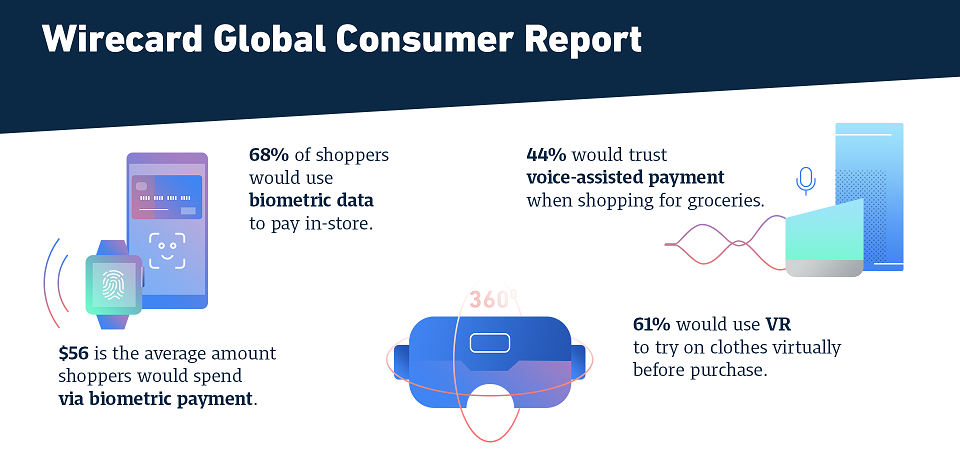
Wirecard research finds majority of consumers are ready and waiting for next-generation technology to improve their shopping experience. „58% of consumers identified mobile payments as being the most important shopping-related technology to improve their buying experience with biometric payments/cashier-less stores second (45%) and VR/Augmented Reality (AR) third with 25%.”, according to the press release.
These findings are part of a global study of 6,000 consumers in select countries in Europe, APAC and the Americas, commissioned by Wirecard, the global innovation leader for digital financial technology.
“Our research has found that the ‘mass market’ of shoppers are now ready to use and adopt innovative new technologies that will improve their in-store shopping experience and make it as easy as possible for them to purchase products in the way that best suits them. These technologies are no longer gimmicks or only used by early adopters, yet many retailers are failing to listen to their customers and keep up with their demands,” commented Markus Eichinger, EVP Group Strategy at Wirecard. “At a time when brick-and-mortar stores are struggling to compete with online sales, combining payments with other technologies is a fundamental step in adding value for customers.”
Key findings:
1. Convenience is king
Globally and regionally, consumers want to use new technologies that make the shopping experience more convenient. This includes using:
. An app to purchase products using the self-checkout (71% somewhat or very interested)
. A smart mirror to allow them to view additional products, request other items and purchase goods without a checkout (65% somewhat or very interested)
. Unmanned stores like Amazon Go (61% somewhat or very interested)
. Virtual reality (VR) to try on items of clothing before buying them online (61% somewhat or very interested).
Interestingly, shoppers from Malaysia, Thailand and Brazil were among the most open to using these new technologies, with shoppers from the US, Australia and France among the lowest. Nearly all (93%) of Thai respondents are very or somewhat interested in using an app to purchase products using the self-checkout, compared to 62% of UK consumers and 51% of Australians. Just 38% of Australians said they are either very or somewhat interested in unmanned stores like Amazon Go, compared to 56% of UK and 88% of Thai consumers.
2. Mobile payments are a given
Mobile payments are important to consumers and should be a given. 44% of consumers said they either somewhat or strongly agree that if a physical store didn’t offer ways to purchase using their mobile phone, they’d be less likely to shop there. 79% of Malaysian consumers said they either strongly or somewhat agreed with this.
When asked which shopping-related technology development they would like to see implemented to improve their buying experience, 58% of survey respondents identified mobile payments as being the most important, with biometric payments/cashier-less stores second (45%) and VR/Augmented Reality (AR) third with 25%.
3. Biometric pays
Wirecard’s research indicates that it pays for retailers to implement biometric payment methods. Three in five would be interested in using biometric data to purchase products online (66%) and in-store (68%). Comparatively, 89% of Thai consumers would be interested in using biometric data to purchase online compared to 53% of German consumers. When using biometric data to authorize payments, consumers are, on average, willing to spend $56. This drops to $43 when authorization isn’t required.
4. Voice-assisted shopping – not as far-fetched as you might think
Despite often being dismissed as a gimmick, 57% either strongly or somewhat agreed that using voice-assisted devices such as Amazon Alexa and Google Home Hub would make shopping easier, and 44% either strongly or somewhat agreed that they would trust voice-assisted payments to do their weekly shop. Once again Thai consumers were the most open to new technologies with 92% either strongly or somewhat agreeing that voice-assisted devices would make shopping easier, compared to 38% of Australians.
5. Customers do their homework online – while in-store
Consumers are interested in using technology to research products while they are in-store before they purchase. 74% are at least somewhat interested in using an app on their phone or the store’s website on their phone to find out more about the product they are looking at, while at least 72% have some interest in using in-store screens such as tablets and 60% are at least interested in using VR.
“A long way from being far-fetched gimmicks, our research shows that there’s a definite appetite for Virtual Reality, voice-assisted shopping, and cashier-less stores. Something needs to change if retail wants to revive footfall in physical stores. The research is there – greater integration of technology is what customers want. Retailers should instead embrace technology, in the same way the modern shopper has,” continued Markus Eichinger.
The independent survey was carried out by Vanson Bourne on behalf of Wirecard in Q4 2019. A total of 6,000 consumers over the age of 18 in select countries in Europe, APAC and the Americas provided answers.
For further insight and more information about consumers’ shopping behavior, download the full e-book here.
Banking 4.0 – „how was the experience for you”
„To be honest I think that Sinaia, your conference, is much better then Davos.”
Many more interesting quotes in the video below: